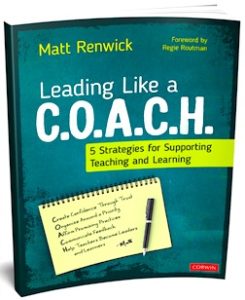Instructional Frameworks for Schoolwide Success
By Matt Renwick

Teachers do not want to be told how to conduct their work any more than other professionals do.
That said, the only times I have experienced or observed a school achieve collective student success is when a faculty came to agreement on (a) the most effective instructional practices, and (b) how and when to utilize them in the classroom.
It’s not enough for a pocket of professionals to improve their expertise while other staff stay with the status quo. All students, and especially kids coming from historically marginalized groups, need excellent instruction every year of their school experience to reach their potential.
This is why an instructional framework is so important for a building leadership team to select and for a faculty to commit to as a school.
Perkins and Reese (2014) describe instructional frameworks as “a vision for more effective teaching and learning.” It provides teachers with “a common perspective and language while allowing adaptation to different subjects, levels, and students.” Some common instructional frameworks include Understanding by Design (Wiggins and McTighe, 2005) and Universal Design for Learning.
Instructional frameworks don’t have to be pre-made. Schools can develop their own. As an example, in my last school we developed an instructional framework to directly support teaching and learning during the pandemic.
It was a condensed version of our previous framework; see below. We only had five different areas with a description for each one. This helped simplify instruction during those challenging times.
- Authenticity: Students engaged in real-world tasks; mistakes encouraged as part of learning
- Being clear: Multiple ways of explaining concepts, such as through shared demonstrations
- Communication: Proactive, using multiple modes and entry points for learning
- Discussion: Student-centered, around important texts and topics
- Empowerment: Voice and choice in what students learn, and building on kids’ interests
What made this framework special is we used feedback from families the school year before. We had asked them to share what they appreciated most about our instruction when we went virtual for those final months of the 2019-2020 school year. The summary of their comments helped form this instructional framework.
Common question: How do you best use an instructional framework?
An instructional framework can also be thought of as a lens for teaching and learning.
Teachers can use it as they prepare instruction. They can keep the framework next to their planning resources, referencing it as they consider how best to guide students toward essential learning outcomes.
In highly effective classrooms, students are offered a window into how the components of an instructional framework can support their learning. For instance, a teacher can break down the elements of student-centered discussion. They may use protocols to ensure equity of voices.
Leaders can also use the framework. They can utilize it as a filter to better “see” instruction.
Seeing the framework in action
For example, during a classroom visit I noticed a teacher had created a writing center. Students could use it for a project or during independent learning time.
I also noticed that, when students engaged with the center, they knew where to go and what to do. The routine and the expectations for this space had been explained and demonstrated with clarity.
After my classroom visit, I thanked the teacher for letting me sit in and observe. I also shared the following written comment with her.

Multiple things were happening in this comment.
►I noticed and named two connections with our instructional framework: authenticity and being clear (bolded).
►I included a comment that noted how the writing center promoted authenticity and clarity.
►My reflective question at the end invited the teacher to share more about her process for aligning her instruction with these elements of the framework.
Our subsequent conversation deepened our knowledge about high quality teaching.
Communicating a vision for teaching and learning through an instructional framework promotes a shared understanding of what high quality looks like in every classroom. It honors teachers as professionals, encouraging flexibility and responsiveness, while maintaining consistency. There is no script to follow, no program to buy to achieve this outcome. Just an expectation for excellence.

Matt is the author of Digital Portfolios in the Classroom: Showcasing and Assessing Student Work (ASCD, 2017) and Leading Like a C.O.A.C.H.: Five Strategies for Supporting Teaching and Learning (Corwin, 2022). Available now at his Read by Example substack is Ten Actions for Supporting Teaching and Learning Playbook. Subscribe to his substack and follow him on X-Twitter @ReadbyExample. Read all his MiddleWeb articles here.




























